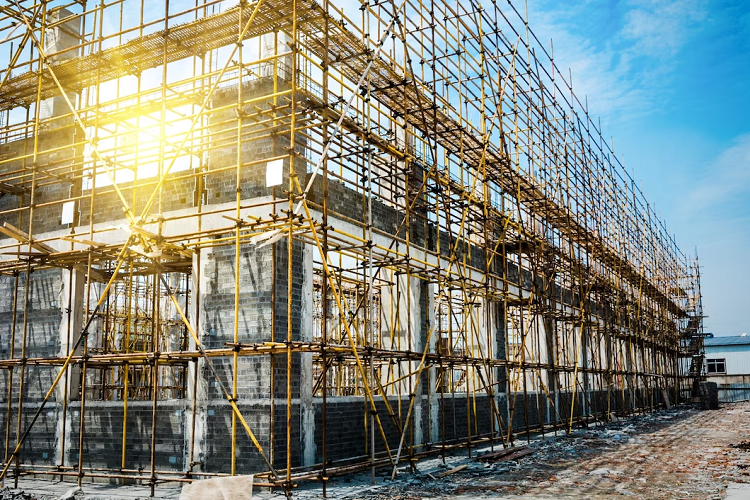The key function of scaffolding is to provide a temporary platform to reach heights and complete tasks without compromising the integrity of the building. With the vast types of scaffolding available, it is crucial to understand each one’s specific purpose and design.
In this blog post, we will guide you through the different types of scaffold and their uses. The goal is to provide you with a better understanding of the different types of scaffolding available and help you determine which one is best suited for your specific needs.
Scaffolding Types and Uses
Single Scaffolding
for light work and maintenance tasks
Single scaffolding are one of the most common types of scaffolding used in the construction industry. They consist of a single row of standards (upright poles) that are fixed to the ground using base plates. The standards are connected by ledgers (horizontal poles) and transoms (diagonal poles) to provide stability to the structure.
Single scaffolding are typically used for light work and maintenance tasks, such as painting and plastering, as they are not designed to withstand heavy loads. It is important to note that single scaffolding should not be used for work at heights exceeding 3 meters and should be inspected regularly to ensure their safety and stability.
Double Scaffolding
for more robust work in construction, painting, and cleaning
Double scaffolding, also known as independent or mason scaffolding, consist of two rows of standards, one on the inside and one on the outside, with cross braces connecting them. These types of scaffolding are ideal for heavy-duty construction, painting jobs, and maintenance tasks that require a larger work area and more stability.
The configuration of double scaffolding allows workers to easily access multiple levels of a structure and move equipment and materials with ease. Additionally, the scaffolding are equipped with guardrails and toe boards that promote safe working conditions for those utilizing the structure. When using double scaffolding, it is important to consider weight limits and secure the scaffolding to prevent tipping or collapse.
Cantilever Scaffolding
for working on areas with limited access
Cantilever scaffolding are a popular scaffold type used in construction sites for working on areas with limited access. They are best suited for projects that require building extensions or working on awkwardly-shaped buildings. This kind of scaffold relies on the support of the building structure rather than on its own legs.
A cantilever scaffold is attached to the building through the use of anchors, which provides extra support and stability, thereby allowing workers to work safely and comfortably at greater heights. This type of scaffold is also suitable for buildings within restricted areas where access is limited and standard scaffolding cannot be used.
Suspended Scaffolding
for high-rise construction, bridge maintenance, and window cleaning
Suspended scaffolding are a type of scaffold that is primarily used in high-rise construction, bridge maintenance, and window cleaning. Suspended scaffolding are suspended or hung from the roof or top of a building using ropes, chains, or cables. They are supported by a fixed anchorage system, and allow workers access to different areas of the building, bridge, or structure. The platform itself is typically made of wood, aluminum, or steel, and can be adjusted to different heights or angles as needed.
Suspended scaffolding are commonly used when traditional scaffolding is not feasible or practical, such as when working on a tall building or bridge. It is important to note that suspended scaffolding need to be installed and maintained by trained professionals to ensure the safety of workers and those in the surrounding area. Proper safety protocols and equipment, such as harnesses and guardrails, should also be in place whenever suspended scaffolding are used.
Mobile Scaffolding
for warehouses, workshops, and factories
Mobile scaffolding are a versatile solution for warehouses, workshops, and factories. These scaffold systems can easily be moved around, providing workers with safe and efficient access to all areas of a workspace.
Mobile scaffolding are ideal for use in areas with limited permanent infrastructure such as high-ceilinged warehouses or in construction sites where the work is constantly shifting. They are designed to provide a stable and secure platform for workers to perform their tasks at height.
The key benefit of mobile scaffolding is their ability to be quickly and easily assembled and dismantled, allowing for the efficient use of labor, time, and materials. These scaffold systems are available in a wide range of sizes and configurations, making them highly customized solutions to fit any workspace needs. Mobile scaffolding are a must-have option for any organization looking to improve the safety and efficiency of their operations.
Conclusion
Scaffolding are a crucial tool in the construction industry, providing a stable and secure platform for workers to operate from. There are many different types of scaffolding, each with its own set of advantages and limitations. Understanding the various types of scaffolding and their uses is essential to ensuring worker safety and the efficient completion of construction projects.
By selecting the right type of scaffold for the job, builders can ensure that they are providing the safest and most effective working environment for their workers, thereby increasing productivity and reducing the risk of accidents and injuries.




